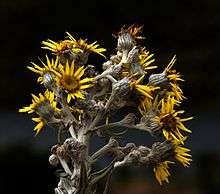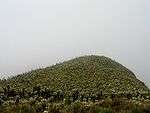Espeletia
Espeletia, commonly known as 'frailejones' ("big monks"[2]), is a genus of perennial subshrubs, in the sunflower family.[3] The genus, which is native mainly to Colombia, Venezuela and Ecuador, was first formally described in 1808.[4] The genus was named after the viceroy of New Granada, José Manuel de Ezpeleta.

| Espeletia | |
|---|---|
| Espeletia in Páramo de Guerrero (Colombia) | |
| Scientific classification | |
| Kingdom: | |
| (unranked): | |
| (unranked): | |
| (unranked): | |
| Order: | |
| Family: | |
| Tribe: | |
| Genus: | Espeletia |
| Synonyms[1] | |
| |
The plants live at high altitude in páramo ecosystems. The trunk is thick, with succulent hairy leaves disposed in a dense spiral pattern. Marcescent leaves help protect the plants from cold. The flowers are usually yellow, similar to daisies.
The frailejón plant is endangered due to destruction of the páramo for agricultural purposes, especially potato crops. This activity continues, despite the Colombian government declaring it illegal. Since about 2010 the plants have also come under attack by beetle larvae, a moth and a fungus, some new to science but suspected to be related to climate change which allows lower-altitude species to flourish.[2]
The Espeletia is well known for contributing to the world in water sustainability by capturing water vapor from passing clouds in its spongy trunk and releasing it through the roots into the soil[2], thus helping to create vast high-altitude subterranean water deposits and lakes that will eventually form rivers.



Species[1]
- Coespeletia palustris Diazgran. & Morillo
- Espeletia ×pachoana Cuatrec.
- Espeletia ×verdeana Cuatrec.
- Espeletia algodonosa Aristeg.
- Espeletia almorzana Cuatrec.
- Espeletia alternifolia Cuatrec.
- Espeletia annemariana Cuatrec.
- Espeletia arbelaezii Cuatrec.
- Espeletia argentea Humb. & Bonpl.
- Espeletia aristeguietana Cuatrec.
- Espeletia aurantia Aristeg.
- Espeletia azucarina Cuatrec.
- Espeletia barclayana Cuatrec.
- Espeletia batata Cuatrec.
- Espeletia boyacensis Cuatrec.
- Espeletia brachyaxiantha S.Díaz
- Espeletia brassicoidea Cuatrec.
- Espeletia cabrerensis Cuatrec.
- Espeletia canescens A.C.Sm.
- Espeletia cayetana (Cuatrec.) Cuatrec.
- Espeletia centroandina Cuatrec.
- Espeletia chocontana Cuatrec.
- Espeletia cleefii Cuatrec.
- Espeletia cochensis Cuatrec.
- Espeletia congestiflora Cuatrec.
- Espeletia conglomerata A.C.Sm.
- Espeletia cuniculorum Cuatrec.
- Espeletia curialensis Cuatrec.
- Espeletia discoidea Cuatrec.
- Espeletia dugandii Cuatrec.
- Espeletia estanislana Cuatrec.
- Espeletia frontinoensis Cuatrec.
- Espeletia garcibarrigae Cuatrec.
- Espeletia grandiflora Humb. & Bonpl.
- Espeletia guascensis Cuatrec.
- Espeletia hartwegiana Cuatrec. ex Cuatrec.
- Espeletia hartwegiana Sch.Bip.
- Espeletia idroboi Cuatrec.
- Espeletia incana Cuatrec.
- Espeletia jajoensis Aristeg.
- Espeletia jaramilloi S.Díaz
- Espeletia killipii Cuatrec.
- Espeletia leporina Cuatrec.
- Espeletia lopezii Cuatrec.
- Espeletia marnixiana S.Díaz & Pedraza
- Espeletia marthae Cuatrec.
- Espeletia miradorensis (Cuatrec.) Cuatrec.
- Espeletia murilloi Cuatrec.
- Espeletia nana Cuatrec.
- Espeletia nemekenei Cuatrec.
- Espeletia occidentalis A.C.Sm.
- Espeletia oswaldiana S.Díaz
- Espeletia paipana S.Díaz & Pedraza
- Espeletia perijaensis Cuatrec.
- Espeletia phaneractis (S.F.Blake) A.C.Sm.
- Espeletia praefrontina Cuatrec.
- Espeletia praesidentis Diazgranados
- Espeletia pycnophylla Cuatrec.
- Espeletia robertii Cuatrec.
- Espeletia rositae Cuatrec.
- Espeletia schultesiana Cuatrec.
- Espeletia schultzii Wedd.
- Espeletia semiglobulata Cuatrec.
- Espeletia smithiana Cuatrec.
- Espeletia standleyana A.C.Sm.
- Espeletia steyermarkii Cuatrec.
- Espeletia summapacis Cuatrec.
- Espeletia tachirensis Aristeg.
- Espeletia tapirophila Cuatrec.
- Espeletia tenorae Aristeg.
- Espeletia tillettii Cuatrec.
- Espeletia tunjana Cuatrec.
- Espeletia ulotricha Cuatrec.
- Espeletia uribei Cuatrec.
- Espeletia weddelii Sch.Bip. ex Wedd.
References
- "Flann, C (ed) 2009+ Global Compositae Checklist". Archived from the original on 2014-11-22. Retrieved 2014-11-22.
- Damian Carrington (9 April 2019). "In the land of El Dorado, clean water has become 'blue gold'". The Guardian.
- Tropicos, Espeletia Mutis ex Bonpl.
- Mutis, José Celestino Bruno ex Bonpland, Aimé Jacques Alexandre in Humboldt, Friedrich Wilhelm Heinrich Alexander von & Bonpland, Aimé Jacques Alexandre. 1808. Plantes équinoxiales recueillies au Mexique : dans l'île de Cuba, dans les provinces de Caracas, de Cumana et de Barcelone, aux Andes de la Nouvelle Grenade, de Quito et du Pérou, et sur les bords du rio-Negro de Orénoque et de la rivière des Amazones 2(9): 10-16 plates 70-72 descriptions in parallel French and Latin, commentary in French, full page line drawings
Further reading
- Padilla-González, G.F., Diazgranados, M., Da Costa, F.B.(2017) Biogeography shaped the metabolome of the genus Espeletia: a phytochemical perspective on an Andean adaptive radiation. Scientific Reports: ISSN 2045-2322 volume 7, Article number: 8835. pdf doi:10.1038/s41598-017-09431-7
External links
| Wikimedia Commons has media related to Espeletia. |